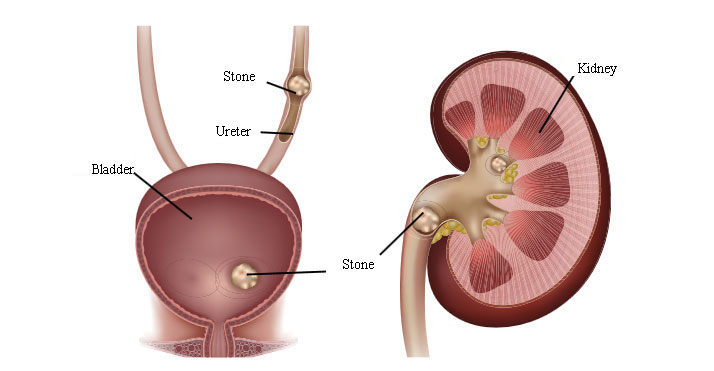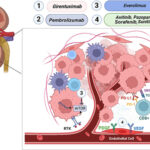Renal colic is a severe, cramp-like pain that occurs when a kidney stone or other obstruction blocks the normal flow of urine in the urinary tract. It is often described as one of the most intense types of pain, typically originating in the flank (side of the abdomen) and radiating to the lower abdomen and groin. This condition is common and can significantly impact a person’s quality of life. Understanding the symptoms, causes, and treatment options for renal colic is essential for both prevention and effective management of the condition.

What is Renal Colic?
Renal colic is caused by the obstruction of the urinary tract, often due to kidney stones, but it can also occur due to other conditions such as infections, tumors, or structural abnormalities in the urinary tract. The pain occurs as the body attempts to move the obstruction through the renal system. When the kidney or ureter (the tube connecting the kidney to the bladder) is blocked, pressure builds up, leading to the sharp, intense pain typical of renal colic.
Causes of Renal Colic
The primary cause of renal colic is kidney stones, which are hardened deposits of minerals and salts that form in the kidneys. These stones can vary in size, and when they move through the urinary tract, they can cause severe pain. However, other conditions may also lead to renal colic, including:
- Kidney Stones: The most common cause, formed from calcium, oxalate, uric acid, or other substances.
- Urinary Tract Infections (UTIs): Infection in the urinary system can cause swelling or scarring that obstructs urine flow.
- Ureteral Strictures: Narrowing of the ureter due to scar tissue from prior surgeries or infections.
- Tumors or Abnormal Growths: Growths in the urinary tract can block the flow of urine, leading to renal colic.
- Hydronephrosis: Swelling of the kidney due to a blockage in the urinary tract.
Symptoms of Renal Colic
The hallmark symptom of renal colic is severe, cramping pain that comes in waves. The pain typically starts suddenly and can vary in intensity. It is often located in the side or lower back but can radiate toward the abdomen, groin, and genitals. Other symptoms of renal colic may include:
- Nausea and Vomiting: The intensity of the pain can often trigger nausea or vomiting.
- Hematuria (Blood in Urine): Small kidney stones may cause bleeding, which leads to blood in the urine.
- Frequent Urination: The blockage can cause an urgent need to urinate or difficulty urinating.
- Painful Urination: As the stone moves through the urinary tract, it can cause a burning sensation during urination.
When to Seek Medical Attention
If you experience severe, unexplained pain in the back or abdomen, especially if accompanied by nausea, vomiting, or blood in the urine, it is important to seek medical attention immediately. Renal colic can indicate a kidney stone or another serious condition that requires timely intervention.
Diagnosing Renal Colic
To diagnose renal colic, healthcare providers typically perform a combination of a physical examination, medical history review, and diagnostic tests. The tests may include:
- Urine Test: To check for signs of infection or blood in the urine, which can indicate kidney stones or other abnormalities.
- Imaging Tests: A CT scan or ultrasound is often used to identify the location, size, and type of obstruction causing the pain. CT scans are particularly useful in detecting kidney stones.
- Blood Tests: To assess kidney function and check for any signs of infection or electrolyte imbalances.
These tests help healthcare providers determine the cause of the renal colic and guide the appropriate treatment options.
Treatment Options for Renal Colic
Treatment for renal colic primarily focuses on relieving pain and addressing the underlying cause of the obstruction. The choice of treatment depends on the severity of symptoms and the size or location of the obstruction.
Pain Management
Since renal colic is associated with intense pain, effective pain management is a crucial aspect of treatment. Common methods include:
- Nonsteroidal Anti-Inflammatory Drugs (NSAIDs): These drugs, such as ibuprofen or naproxen, help reduce pain and inflammation.
- Opioid Pain Relievers: In severe cases, stronger pain medications may be required for short-term use to manage the acute pain.
- Antispasmodic Medications: These help relieve muscle spasms in the urinary tract caused by the obstruction.
Stone Removal
If the renal colic is caused by a kidney stone, the treatment plan will focus on removing the stone or facilitating its passage.
- Conservative Management: For small stones (less than 5mm), doctors may recommend drinking plenty of fluids and using medications to help pass the stone naturally. Pain management is also critical during this process.
- Extracorporeal Shock Wave Lithotripsy (ESWL): For larger stones, ESWL uses sound waves to break the stones into smaller pieces, which can then be passed through the urinary tract.
- Ureteroscopy: A thin, flexible tube is inserted through the urethra and bladder to remove or break up stones in the ureter.
- Percutaneous Nephrolithotomy: This surgical procedure is used for very large kidney stones, where a small incision is made in the back to remove the stone.
Addressing Underlying Causes
In cases where renal colic is caused by conditions such as infections or tumors, the treatment will focus on addressing the underlying issue. For example, urinary tract infections are treated with antibiotics, while tumors may require surgical removal or other therapies.
Preventing Renal Colic
While not all cases of renal colic can be prevented, certain lifestyle changes and strategies can help reduce the risk of kidney stones and other obstructions:
- Hydration: Drinking plenty of water helps prevent kidney stones by diluting the substances that cause stones to form.
- Dietary Modifications: Reducing sodium, oxalate, and animal protein intake can help lower the risk of stone formation. Increasing consumption of fruits and vegetables can also be beneficial.
- Avoiding Excessive Use of Certain Medications: Long-term use of certain medications, such as diuretics or calcium supplements, can increase the risk of stone formation. Discuss any concerns with a healthcare provider.
Complications of Renal Colic
If left untreated, renal colic can lead to serious complications, including:
- Infection: Blockages in the urinary tract can lead to infections, including kidney infections (pyelonephritis), which can be life-threatening if not treated.
- Hydronephrosis: Long-term obstruction can cause swelling of the kidney, leading to permanent kidney damage if not addressed promptly.
- Chronic Pain or Recurrence: Some individuals may experience recurrent episodes of renal colic, especially if the underlying causes are not adequately addressed.
Renal colic is a common yet excruciating condition that can significantly impact a person’s life. Understanding its causes, symptoms, and treatment options is essential for managing the condition and preventing recurrence. Early diagnosis and appropriate treatment, including pain management, stone removal, and addressing underlying causes, are key to reducing the severity of renal colic and improving overall patient outcomes.

